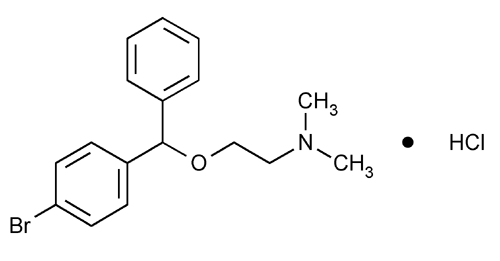Bromodiphenhydramine Hydrochloride
Ethanamine, 2-(4-bromophenyl)phenylmethoxy-N,N-dimethyl-, emsp;hydrochloride.
2-(p-Bromo-
» Bromodiphenhydramine Hydrochloride contains not less than 98.0 percent and not more than 101.0 percent of C17H20BrNO·HCl, calculated on the dried basis.
Packaging and storage—
Preserve in tight containers.
Identification—
B:
Ultraviolet Absorption  197U
197U —
—
Solution:
15 µg per mL.
Medium:
0.1 N sulfuric acid.
Absorptivities at 228 nm, calculated on the dried basis, do not differ by more than 3.0%.
Loss on drying  731
731 —
Dry it at 105
—
Dry it at 105 for 3 hours: it loses not more than 0.5% of its weight.
for 3 hours: it loses not more than 0.5% of its weight.
Assay—
Dissolve about 700 mg of Bromodiphenhydramine Hydrochloride, accurately weighed, in 50 mL of glacial acetic acid, and add 10 mL of benzene and 15 mL of mercuric acetate TS. Add 2 drops of crystal violet TS, and titrate with 0.1 N perchloric acid VS to a green endpoint. Perform a blank determination, and make any necessary correction. Each mL of 0.1 N perchloric acid is equivalent to 37.07 mg of C17H20BrNO·HCl.
Auxiliary Information—
Please check for your question in the FAQs before contacting USP.
Chromatographic Column—
| Topic/Question | Contact | Expert Committee |
| Monograph | Daniel K. Bempong, Ph.D.
Senior Scientist 1-301-816-8143 |
(MDPS05) Monograph Development-Pulmonary and Steroids |
| Reference Standards | Lili Wang, Technical Services Scientist 1-301-816-8129 RSTech@usp.org |
USP32–NF27 Page 1710
Chromatographic columns text is not derived from, and not part of, USP 32 or NF 27.
